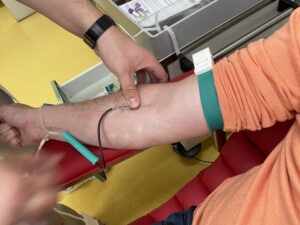Here are a few important things May-Grant OB/GYN would like you to know about Cervical Cancer and Cervical Health Awareness.

The cervix is the opening to the uterus and is located at the top of the vagina. It is covered by a thin layer of tissue made up of two types of cells: 1) “skin-like” cells called squamous cells and 2) glandular cells that produce the mucus in the cervix.
Cervical cancer occurs when cervical cells become abnormal and grow out of control. Over time, the cancer cells can invade deeper into the cervical tissue and can spread to other organs of the body. It usually takes 3 to 7 years for high- grade changes in cervical cells to become cancerous.
Most cases of cervical cancer are caused by certain strains of HPV (human papillomavirus).
Cervical cancer screening is used to find changes in the cells of the cervix that could lead to cancer. Screening includes cervical cytology (also called the Pap test or Pap smear), testing for human papillomavirus (HPV), or both. Most women should have cervical cancer screening on a regular basis.
Cervical cancer screening is an important part of women’s health care. You should start having screening at age 21, regardless of when you first start having sex.
How often you should have cervical cancer screening and which tests you should have depend on your age and health history, but here are general guidelines: Women who are 21 to 29 should have a Pap test alone every 3 years. HPV testing alone can be considered for women who are 25 to 29, but Pap tests are preferred.
Women who are 30 to 65 have three options for testing. They can have a Pap test and an HPV test (co-testing) every 5 years. They can have a Pap test alone every 3 years. Or they can have HPV testing alone every 5 years.
Depending on your health history and risk factors, you may need testing more often. Your provider will advise you on what is appropriate for you. Even though you may not need a cervical screen, it is important to see your ob/gyn provider every year for an annual exam for your overall health and wellness and any other necessary screening tests. (Info abstracted from ACOG—the American College of Obstetrics and Gynecology)
Cervical cancer was once a leading cause of cancer death for women in the United States. Today, screening and prevention have greatly reduced the impact of this form of cancer. However, nearly 14,100 women in the United States received a diagnosis of cervical cancer and nearly 4,300 died from the disease last year, according to the National Cancer Institute.
Increasing screening and prevention are key components of the effort to eradicate cervical cancer. Since almost all cases of the disease are caused by human papillomavirus (HPV) infection, vaccines that protect against the virus could prevent the vast majority of cases. Moreover, regular Pap tests can catch – and lead to the treatment of – the disease at the precancerous stage.
Cervical cancer is among a number of cancers that can be caused by infections with pathogens – bacteria, viruses, and parasites.
WHAT IS CERVICAL CANCER?
Cervical cancer is a disease in which cancer cells arise in the cervix, which connects the uterus to the vagina. HPV is almost always the cause of cervical cancer, which is why vaccines against the virus are an important part of cervical cancer prevention strategies.
The U.S. Food and Drug Administration (FDA) has approved three vaccines – Gardasil, Gardasil 9, and Cervarix – that prevent infection with certain subtypes of HPV including 16 and 18, two high-risk HPVs that cause some 70 percent of cervical cancers.
In a study published in Cancer Epidemiology, Biomarkers & Prevention, a journal of the American Association for Cancer Research (AACR), researchers investigated the types of HPV infections in 12,514 women aged 15 to 45 and found that the seven subtypes of the virus targeted by Gardasil 9 accounted for about 91 percent of the most advanced cervical precancers, meaning that Gardasil 9 could prevent nine out of 10 cases of cervical cancer.
“If vaccination programs with this new-generation vaccine are effectively implemented, approximately 90 percent of invasive cervical cancer cases worldwide could be prevented, in addition to the majority of precancerous lesions,” said senior author Elmar A. Joura, MD, an associate professor of gynecology at the Medical University of Vienna in Austria.
But there is a lack of public awareness and adherence to vaccination programs in the U.S. The Centers for Disease Control and Prevention (CDC) recommends vaccination for girls and boys ages 11 to 12.
A 2015 article in Cancer Epidemiology, Biomarkers & Prevention reported on a national survey that found many pediatricians and primary care physicians communicate about HPV vaccination in ways that may discourage parents from getting their children vaccinated.
“We are currently missing many opportunities to protect today’s young people from future HPV-related cancers,” said Melissa B. Gilkey, PhD, the article’s lead author and an assistant professor of population medicine at Harvard Medical School and Harvard Pilgrim Health Care Institute in Boston.
Usually, cervical cancer develops slowly over time, and another powerful preventive measure is Pap test screening, a procedure during which cells are collected from the surface of the cervix and examined. The Pap test can both detect cancer at an early stage, when treatment outcomes tend to be better, and detect precancerous abnormalities, which can then be treated to prevent them from developing into cancers.
WHAT THE AACR IS DOING IN THE AREA OF CERVICAL CANCER RESEARCH
The American Association for Cancer Research (AACR) is currently supporting three scientific grants in this area, two under the Beginning Investigator Grant for Catalytic Research (BIG Cat) Initiative and one through the Victoria’s Secret Global Fund for Women’s Cancers Career Development Award, in Partnership with Pelotonia & AACR. Researchers are studying evolving genetic factors for cervical cancer in women of African ancestry, epigenetic biomarkers of anal HPV infection in women with cervical HPV, and the feasibility of adjuvant topical therapy for cervical pre-cancer treatment.
SUPPORT CANCER RESEARCH
There are many ways in which you can lend your talents to support lifesaving research. Learn how you can become an advocate for cancer research, participate in events to raise awareness, volunteer your time, and share your story of how cancer has affected your life.





































